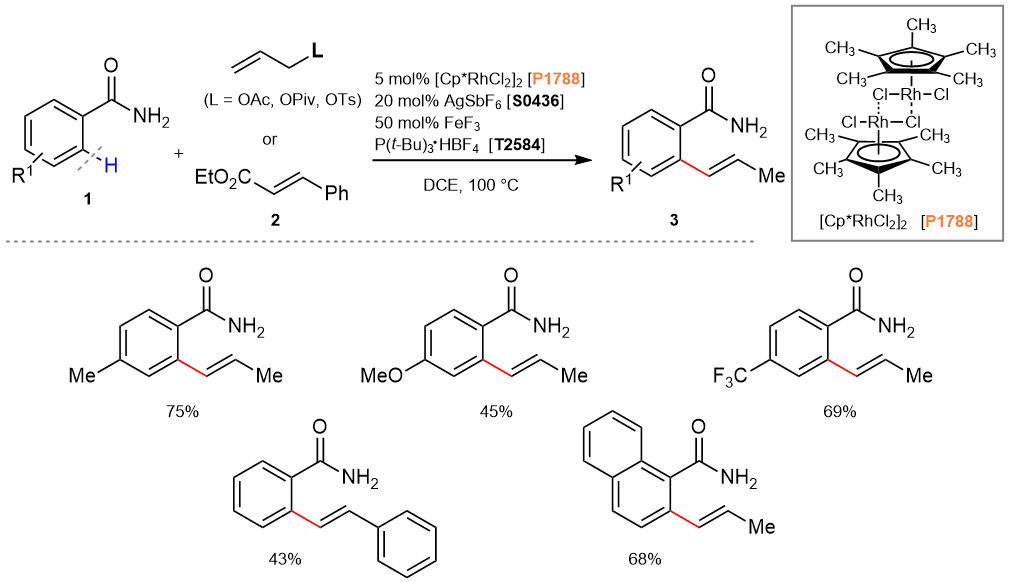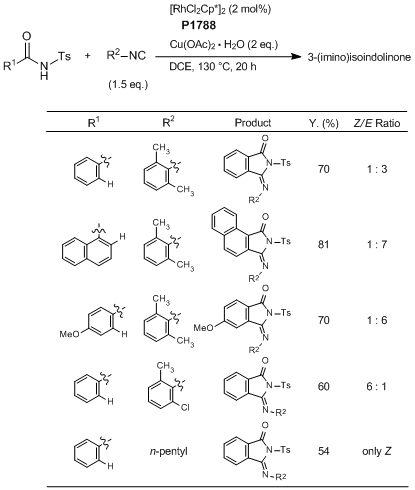Maximum quantity allowed is 999
Please select the quantity
CAS RN: 12354-85-7 | Product Number: P1788
(Pentamethylcyclopentadienyl)rhodium(III) Dichloride Dimer

Purity: >96.0%(T)
Synonyms:
- Dichloro(pentamethylcyclopentadienyl)rhodium(III) Dimer
- [RhCp×Cl2]2
Product Documents:
| Size | Unit Price | Same Day | 2-3 Business Days | Other Lead Time |
Shipping Information

|
|---|---|---|---|---|---|
| 200MG |
NT$6,888
|
24 | 39 | Contact Us | |
| 1G |
NT$26,754
|
≥60 | ≥100 | Contact Us |
* The above prices include freight cost, customs, and other charges to the destination except for products that need to be shipped by sea or dry ice. For details, please contact
our distributor
in Taiwan to order our product.
* The storage conditions are subject to change without notice.
| Product Number | P1788 |
| Purity / Analysis Method | >96.0%(T) |
| Molecular Formula / Molecular Weight | C__2__0H__3__0Cl__4Rh__2 = 618.07 |
| Physical State (20 deg.C) | Solid |
| Storage Temperature | Room Temperature (Recommended in a cool and dark place, <15°C) |
| Packaging and Container | 1G-Glass Bottle with Plastic Insert (View image), 200MG-Glass Bottle with Plastic Insert (View image) |
| CAS RN | 12354-85-7 |
| PubChem Substance ID | 87560640 |
| MDL Number | MFCD00061552 |
Specifications
| Appearance | Light yellow to Brown powder to crystal |
| Purity(Argentometric Titration) | min. 96.0 % |
Properties (reference)
GHS
| Pictogram |

|
| Signal Word | Warning |
| Hazard Statements | H302 + H312 + H332 : Harmful if swallowed, in contact with skin or if inhaled. H315 : Causes skin irritation. H319 : Causes serious eye irritation. |
| Precautionary Statements | P501 : Dispose of contents/ container to an approved waste disposal plant. P261 : Avoid breathing dust/ fume/ gas/ mist/ vapors/ spray. P270 : Do not eat, drink or smoke when using this product. P271 : Use only outdoors or in a well-ventilated area. P264 : Wash skin thoroughly after handling. P280 : Wear protective gloves/ protective clothing/ eye protection/ face protection. P337 + P313 : If eye irritation persists: Get medical advice/ attention. P305 + P351 + P338 : IF IN EYES: Rinse cautiously with water for several minutes. Remove contact lenses, if present and easy to do. Continue rinsing. P362 + P364 : Take off contaminated clothing and wash it before reuse. P332 + P313 : If skin irritation occurs: Get medical advice/ attention. P301 + P312 + P330 : IF SWALLOWED: Call a POISON CENTER/doctor if you feel unwell. Rinse mouth. P302 + P352 + P312 : IF ON SKIN: Wash with plenty of water.Call a POISON CENTER/doctor if you feel unwell. P304 + P340 + P312 : IF INHALED: Remove person to fresh air and keep comfortable for breathing. Call a POISON CENTER/doctor if you feel unwell. |
Related Laws:
Transport Information:
| H.S.code* | 2843.90-000 |
Application
Cp*-Rh catalyzed oxidative Heck reaction

References
- The Rhodium-catalyzed Selective Oxidative Heck Reaction of Amides with Allylic Esters
Application
Cp*-Rh catalyzed Direct Ar-H Sulfonamidation and Amination Reactions

References
- Rhodium(III)-catalyzed Direct C-7 Sulfonamidation and Amination of Indolines with Arylsulfonamides and Trifluoroacetamide
Application
Rhodium-catalyzed Annulation of N-Benzoylsulfonamide with Isocyanide through C―H Activation

Typical Procedure:
N-Benzoyl-4-methylbenzenesulfonamide (27.5 mg, 0.1 mmol), [RhCl2Cp*]2 (1.2 mg, 0.002 mmol) and Cu(OAc)2·H2O (40.0 mg, 0.2 mmol) are loaded in a dry vial which is subjected to evacuation/flushing with dry argon three times. A solution of 2,6-dimethylphenyl isocyanide (19.6 mg, 0.15 mmol) in anhydrous dichloroethane (0.8 mL) is syringed into the mixture that is then stirred at 130 °C for 20 h or until the starting material has been consumed as determined by TLC. Upon cooling to room temperature, all volatiles are evaporated and the residue is purified by preparative TLC (ethyl acetate : hexane = 1 : 2) to give the corresponding 3-(imino)isoindolinone derivative (Y. 70%, E/Z = 3 : 1). Z and E isomers are further separated by preparative TLC (methylene chloride : hexane = 10 : 1).
N-Benzoyl-4-methylbenzenesulfonamide (27.5 mg, 0.1 mmol), [RhCl2Cp*]2 (1.2 mg, 0.002 mmol) and Cu(OAc)2·H2O (40.0 mg, 0.2 mmol) are loaded in a dry vial which is subjected to evacuation/flushing with dry argon three times. A solution of 2,6-dimethylphenyl isocyanide (19.6 mg, 0.15 mmol) in anhydrous dichloroethane (0.8 mL) is syringed into the mixture that is then stirred at 130 °C for 20 h or until the starting material has been consumed as determined by TLC. Upon cooling to room temperature, all volatiles are evaporated and the residue is purified by preparative TLC (ethyl acetate : hexane = 1 : 2) to give the corresponding 3-(imino)isoindolinone derivative (Y. 70%, E/Z = 3 : 1). Z and E isomers are further separated by preparative TLC (methylene chloride : hexane = 10 : 1).
References
PubMed Literature
Articles/Brochures
TCIMAIL
Product Documents (Note: Some products will not have analytical charts available.)
Safety Data Sheet (SDS)
Please select Language.
The requested SDS is not available.
Please Contact Us for more information.
Specifications
C of A & Other Certificates
Please enter Lot Number
Incorrect Lot Number. Please input only the 4-5 alphanumeric characters before the hyphen.
Sample C of A
This is a sample C of A and may not represent a recently manufactured lot of the product.
A sample C of A for this product is not available at this time.
Analytical Charts
Please enter Lot Number
Incorrect Lot Number. Please input only the 4-5 alphanumeric characters before the hyphen.
The requested analytical chart is not available. Sorry for the inconvenience.



